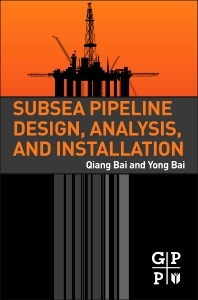Description
Subsea Pipeline Design, Analysis, and Installation
Authors: Bai Qiang, Bai Yong
Language: English
Subjects for Subsea Pipeline Design, Analysis, and Installation:
Publication date: 04-2014
824 p. · 15x22.8 cm · Hardback
824 p. · 15x22.8 cm · Hardback
Description
/li>Contents
/li>Readership
/li>Biography
/li>Comment
/li>
As deepwater wells are drilled to greater depths, pipeline engineers and designers are confronted with new problems such as water depth, weather conditions, ocean currents, equipment reliability, and well accessibility. Subsea Pipeline Design, Analysis and Installation is based on the authors' 30 years of experience in offshore. The authors provide rigorous coverage of the entire spectrum of subjects in the discipline, from pipe installation and routing selection and planning to design, construction, and installation of pipelines in some of the harshest underwater environments around the world. All-inclusive, this must-have handbook covers the latest breakthroughs in subjects such as corrosion prevention, pipeline inspection, and welding, while offering an easy-to-understand guide to new design codes currently followed in the United States, United Kingdom, Norway, and other countries.
PART I: MECHANICAL DESIGN
- Introduction
- Wall-thickness and Material Grade Selection
- Buckling/Collapse of Deepwater Metallic Pipes
- Limit-State Based Strength Design
PART II: PIPELINE DESIGN
- Hydraulic Analysis of Subsea Pipelines
- Soil and Pipe Interaction
- Hydrodynamics around Pipes
- Finite Element Analysis of In-situ Behavior
- Thermal Expansion Design
- Lateral Buckling and Pipeline Walking
- Upheaval Buckling
- Fatigue and ECA
- On-Bottom Stability
- Pipeline Spans and VIV Fatigue
- Force Model and Wave Fatigue
- Trawl Impact, Pullover and Drop Objects
- Pipe-in-Pipe and Bundle Systems
- Seismic Design
- Corrosion Prevention and Advanced CP Design
- Arctic Pipelines
- Subsea Survey and Positioning
- Route Optimization, Shore Approach, Tie-in and Protection
- Asgard Flowlines Design Examples
PART III: FLEXIBLE AND RTP PIPELINES
- Flexible Pipeline
- Cross-Sectional and Dynamic Analysis of Flexible Pipes
- Tensile/Compressive Strength of RTP Pipeline
- Burst Strength of RTP Pipeline
- Collapse of RTP Pipeline
- Offshore Installation of RTP Pipeline
- On-bottom Stability of RTP Pipeline
PART IV: STEEL LINEPIPE, WELDING AND INSTALLATION
- Use of High Strength Steel
- Welding and Defect Acceptance
- Installation
- Pipeline Commissioning, Operations and Maintenance
Piping Engineers, Designers, Civil Engineers, Mechanical Engineers, Petroleum Engineers and Chemical Engineers, Project Production Engineer, and Project Reservoir Engineer
Dr. Qiang Bai obtained a doctorate for Mechanical Engineering at Kyushu University, Japan in 1995. He has more than 20 years of experience in subsea/offshore engineering including research and engineering execution. He has worked at Kyushu University in Japan, UCLA, OPE, JP Kenny, and Technip. His experience includes various aspects of flow assurance and the design and installation of subsea structures, pipelines and riser systems. Dr. Bai is the coauthor of Subsea Pipelines and Risers.
Dr. Yong Bai holds the position of Chair Professor at Zhejiang University (China) and is also an academician at the Norwegian Academy of Technical Sciences. He is a fellow of the US Society of Naval Architects and Marine Engineers and the UK Royal Institution of Naval Architects. With an extensive background in offshore engineering structures and pipelines, Prof. Bai has held professorships at renowned universities, significantly contributing to the global offshore oil and gas industry through his publications and innovative achievements.
Dr. Yong Bai holds the position of Chair Professor at Zhejiang University (China) and is also an academician at the Norwegian Academy of Technical Sciences. He is a fellow of the US Society of Naval Architects and Marine Engineers and the UK Royal Institution of Naval Architects. With an extensive background in offshore engineering structures and pipelines, Prof. Bai has held professorships at renowned universities, significantly contributing to the global offshore oil and gas industry through his publications and innovative achievements.
- Gain expert coverage of international design codes
- Understand how to design pipelines and risers for today's deepwater oil and gas
- Master critical equipment such as subsea control systems and pressure piping
© 2024 LAVOISIER S.A.S.



